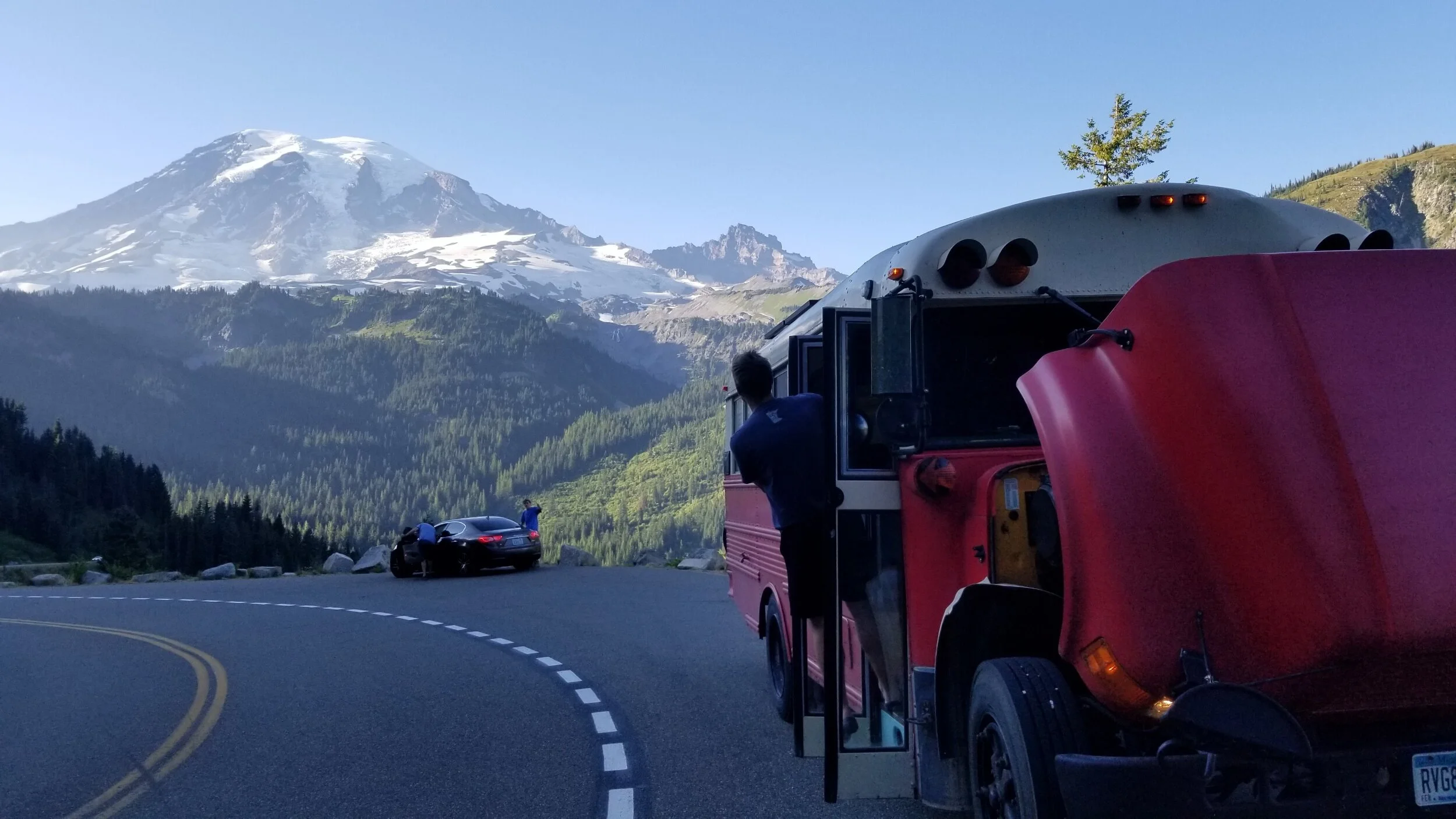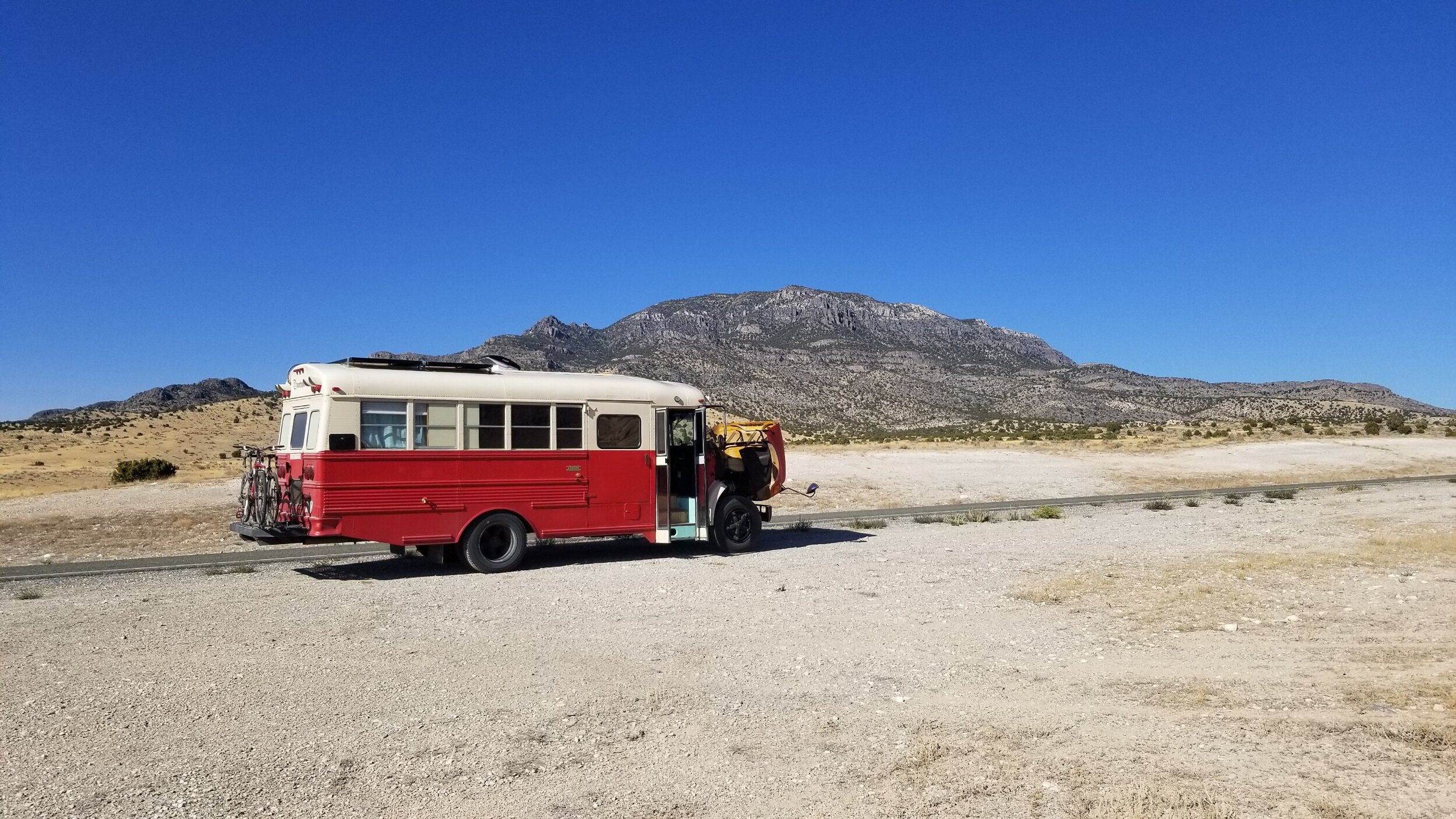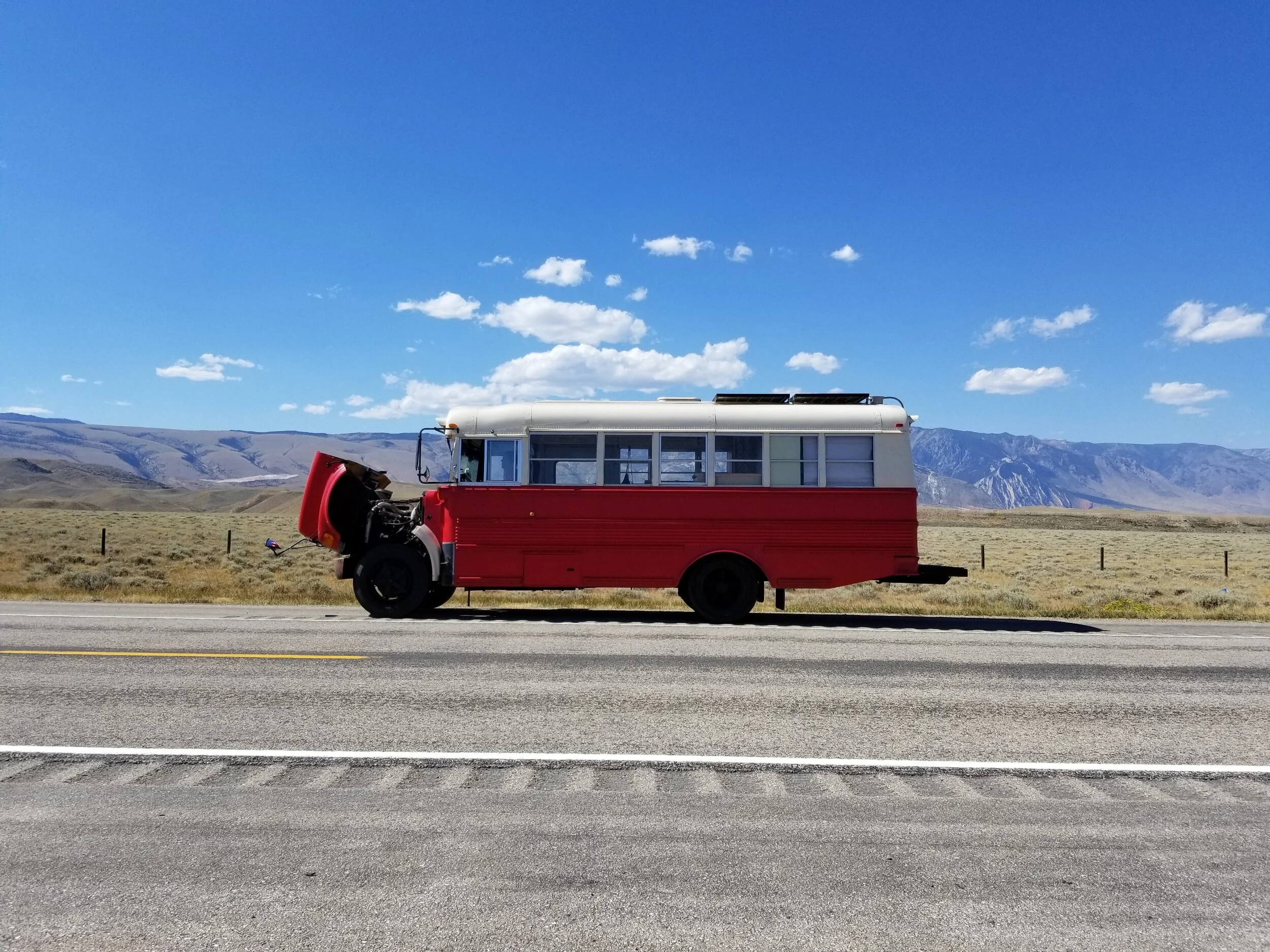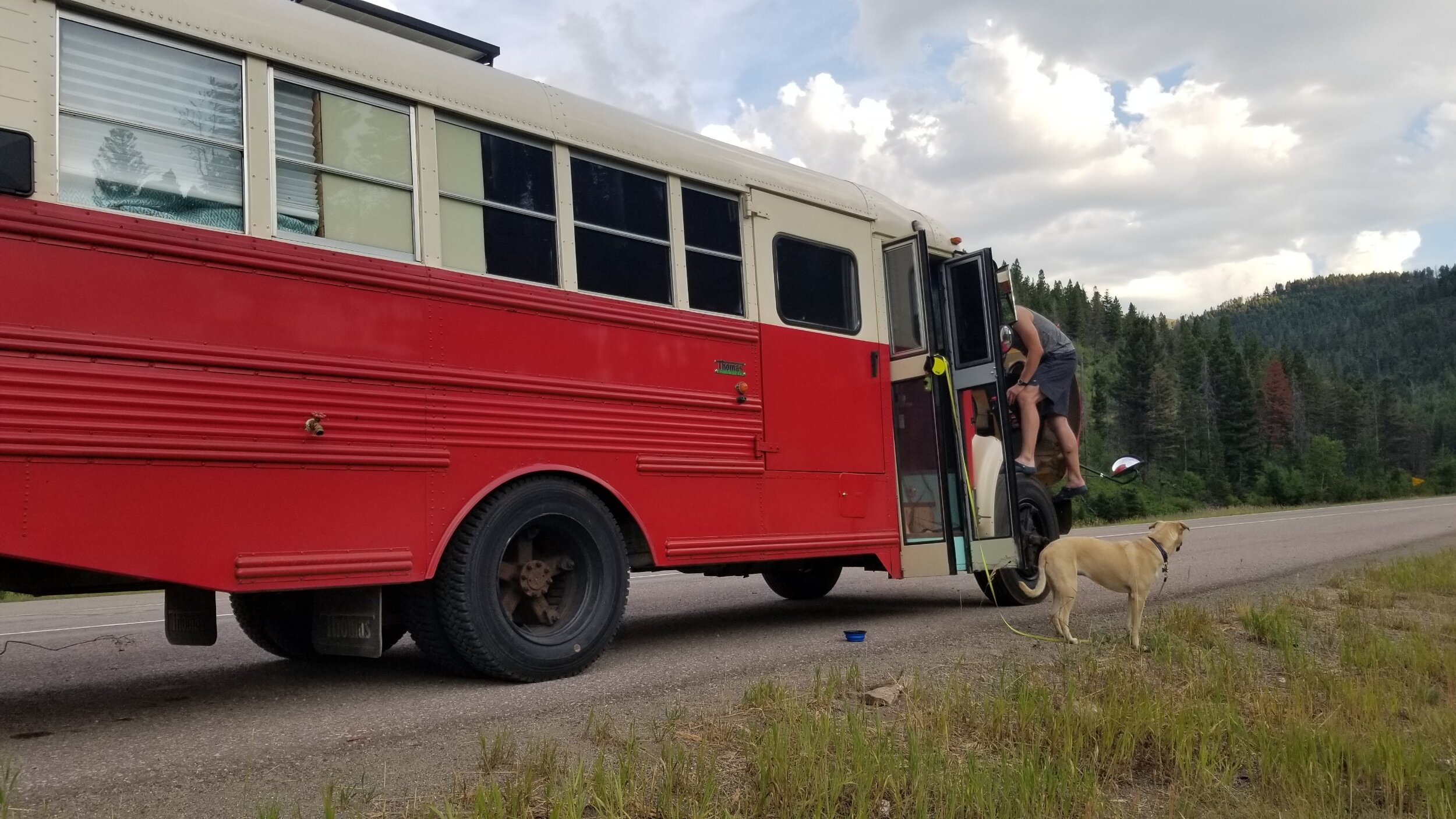Bad Blood (it's temporary)
Disclaimer: neither Jake nor myself are diesel mechanics nor have an extensive background in engines. What we explain here may or may not be the full story or even the accurate story, but it’s what we (mostly Jake) have learned and interpreted from experts along the way.
If you have followed our Ruby journey for much time, you will quickly catch wind that we have struggled and stumbled along with Ruby’s overheating episodes since the beginning of time (literally since our first drive off the lot we purchased it from).
It’s been a manageable problem, but after living and traveling in Ruby for some months now, we have been searching and keeping our ears open (some days more desperately than others) for a potential fix.
When it started…
We first began noticing overheating the day we drove Ruby north from Minneapolis to central MN. About a 2 hour journey that quickly turned into much more than 2 hours. We were also having some intermittent dash issues, so we were unsure if the temp meter was correct or not, but cautiously found ourselves in numerous gas stations buying numerous gallons of coolant to get us to our destination. We contacted the person we bought it from, but in his entire time owning Ruby, he had maybe put 50 miles on the bus, so never really had the chance to get to know her on the level we were :)
And then again…
After our first interesting journey, we brought the bus in to get looked over. We mentioned the overheating issue, but the mechanic found nothing abnormal to flag and fix. Since a few months had passed throughout the conversion, we decided to see how she would do this time around. The problem persisted…our first cross-country trip with Ruby in the fall of 2019 (maiden voyage post here), we had a tight timeline to make it to a friends’ wedding festivities, so we had to push through the North Dakota August heat, only stopping for Ruby to cool down. It was a pretty miserable drive with a lot of stress. We traveled for a couple weeks out west after the wedding and it only got worse as we hit the mountains…
We attempted Bear Tooth Pass and had to turn around within minutes of starting. We soon realized the combination of heat and elevation made the problem exponentially worse. Just heat she could semi-handle, but add in elevation gain and she’s donezo.
SO, when we got back from that trip, we started doing research - reading forums, scanning the bus community, and consulting with people who know the in-and-outs of diesel engines & radiators (S/O to Uncle Joe!!) Multiple mechanics had told us things like “she’s just not built to climb mountains” which we couldn’t really argue with being it’s a MN built bus used for inner-city driving during the school year. But the more we read, the more we found others had reported this problem. Unfortunately, we were unable to really find much consistency in what people did or we would find what people did but the results were nothing great and the fixes were spendy.
What we do when she overheats…
Once the temp gauge gets into the red, we pull off of the road or on the side of the highway, open the hood, and wait 5-10 minutes until she gets back to her nominal temp. Then, we start driving. And depending on the terrain we are in, we often will drive some miles and repeat the same process. In her worst, not even miles, but fractions of miles :) I think our max number of stops in a single summit was counted at 8 - and 8 stops = ~80 added minutes on potentially a 8 mile climb or less. P.A.I.N.F.U.L. But it was our reality for a while! It wasn’t ideal, but it also never put us in a situation where we felt we needed to call a tow truck (to look at it positively). We also had every opportunity to stop and smell the roses & snap sweet pics in the middle of the desert or sunsets if we were lucky. The first steps…
1) Make sure you have coolant - remember that when you funk with the bus’s heat system (which you likely have to do during the conversion), the coolant will nearly empty. Running an engine without coolant will quickly cause overheating…
Cost: tbd, as much coolant as you may need
2) Drain coolant & clean the radiator - we completely emptied the cooling system and tossed the old coolant - it was very murky. Once empty, we ran water and this radiator cooling stuff through the cooling system. Read the bottle & follow those directions :) I promise they will be better than the ones I provide here.
Cost: ~$200 (coolant is about $20 / gallon + cleaning solution)
3) Replace the thermostat - there is a thermostat in your cooling system that allows coolant to flow through your radiator once a specific temp is reached. It’s a pretty cheap replacement to potentially make a lot of impact. However, for us, it was minimal. :/ We weren’t sold this was the problem as it seemed every time we fired up Ruby, the fan would run, but it was worth the peace of mind.
Cost: ~$70
4) **Shutters - we decided to completely remove the shutters as they were only blocking airflow. We really don’t plan on doing much winter camping (although the lows in the CO mountains are in the 20s!), but if you are wanting to run your rig in the cold winter days, this may not be a great option for you. But for us, it seemed like a wasted piece that only restricted airflow to the radiator.
Cost: $0
5) Find a good diesel mechanic - I actually don’t recommend leaving this for step 5, probably should be the first step, but not all have this kind of luck :) We hit up a shop in Cedar City, UT (s/o to Amen Diesel) to get a routine oil change. The shop seemed knowledgable and had tens of semis around. We passively brought up the overheating issue & something we hadn’t heard before was suggested - replace the viscous fan clutch with a direct drive. We were told this would cost around $500 and were desperate at this point to try something. So we did…
Cost: $750
**We did Steps 1 - 4 prior to hitting the road FT in 2020 - we noticed a pretty sizable change in Ruby’s tolerance, but once we hit the mountains, it was still a significant amount of time on the side of the road… :/
Why a direct drive?
I’m sure I will butcher this (see disclaimer above), but I’m going to try explaining with Jake’s editing help…
The radiator in Ruby is split in half vertically with different functions of each side of the radiator - one is directly to cool the engine & the other one is for the turbo (we think anyways…) The engine gets much hotter than the turbo - like a lot…we temped them with a temp gun while it was overheating and found a variation of about 80 degrees! The fan clutch (looks like a 4-6” diameter fan) is centered in the middle of the two radiator halves. The fan clutch has a fluid that expands as it gets hot and causes the fan to engage more. With the placement of the fan clutch, the output speed of the fan directed from the clutch is an average of the two inputs, so the fan is never running at the speed it needs to in order to cool the engine.
On a high level, the direct drive makes the fan run at 100% of the engine RPMs at all times instead of being engine temperature dependent (typically running somewhere between 20-80% of the engine RPMs). Obviously a faster fan means more air flow and quicker cooling.
How much did it cost?
It ended up costing us (parts + labor) around $750. Due to all of the overheating previously, the fan clutch was essentially welded into place and took some extra labor to remove. The part itself was around $250 though, so if you have know a guy who knows a guy, it may even be cheaper ;)
Has it been successful??
The question we have all been wondering since we got to drive Ruby out of the shop - 3 extra days in town and a couple homeless days later…
Ruby has been out of the shop for over 2 weeks and hasn’t overheated or hardly even gone past nominal temp since!
We are also in Colorado now and have driven through multiple 11,000+ ft passes, been through the Million Dollar Highway in the San Juans, and crossed over the Rockies to the east. Although I cannot say for certain that we will never have overheating problems again, we are very certain we would have added up tens of hours in just the past 2 weeks cooling down if not for it. These are probably the gnarliest and most intense mountains we have driven through ever with Ruby, so definitely a good test!
In summary…
For us and with the success we have had thus far, it was well worth the money! My only hope is that she continues to perform at this level :) It has really given us confidence in driving through mountain passes and giving us some flexibility of driving in the middle of the day without much concern of the outside temp. As I know this is a common issues among the skoolie community, I hope this hits home for some and maybe gives you an idea of what may work for your bus :D But as always, trust the experts! Out with the old anthem, Girl on Fire, and in with the new - Cool ;)
Peace, love, and happy trails,
yo’ girl Jen (with a throwback because it feels like a high five moment)
















